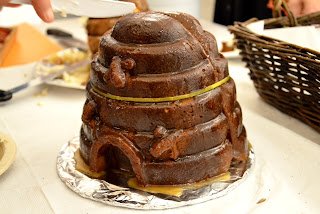 |
| The garden and house in Callicoon |
Sunday morning, April 15, we were up bright and early, excited about the day ahead. The Georgetown Honeybee guys were on their way to deliver our Italian bees and we were the first on the route since we had to drive the bees to their new home in upstate New York, about two hours away. As much as we would have loved to contribute to urban beekeeping, our Brooklyn apartment does not have a rooftop or space to accommodate a hive. The house in Callicoon however, is the perfect setting for the bees!
 |
A package of bees -
Each box contains 3 pounds of bees (about 10,000 bees),
a can with syrup feed, and a smaller cage containing
the queen bee and a few attendants.
|
We came down to meet the guys at their SUV which was tightly packed with hive parts and bee packages. They opened the trunk and there they were... each screened box contained a tight buzzing formation protecting its new queen. The thing about packages is that most often they are made up of bees from many different hives. Fortunately, the bees will only experience this uprooting once in their lifetime. It is in the transportation process however, that they come to know each other and the queen, who emits a pheromone to communicate and bond with them. All bees secrete different kinds of pheromones, but none is more important than that of the queen bee, since it affects the social behavior and inner workings of the hive.
We loaded our car with the hive components and bees and after a few more recommendations from the Georgetown Honeybee guys, we were on the road. We felt a mixture of excitement as well as apprehension, having never done this before. Fortunately, we had thought of calling upon an experienced beekeeper to guide us through the installation. We heard about Claire from Robin, the owner of the Callicoon Wine Merchant and Windy Hill Cheese Shop (
Callicoon is such a wonderful little town). Claire keeps many hives, both in the city and in the Catskills, in a town about 20 minutes from Callicoon; she also founded
Catskill Provisions, through which she sells honey, mapple syrup and other related goodies.
 |
| Deep, package and tools |
As soon as we arrived, we set out to find the perfect spot for the hive, somewhere not too close to the house, but not too far either, somewhere with enough shade to keep them cool in the summer months, but where the morning sun could warm the hive in winter months. We prepared a spray with sugar water, laid out our tools, and readied the main part of the hive (or "deep super"). Once the deep was steadied, we proceeded to the release of the bees.
 |
The queen and her attendants -
The queen is in a small screened box which allows the other
bees to see her, smell her and feed her. This will go on until
the bees have been installed in their new hive and the bees
have released the queen by eating through a small piece of
candy that acts as a stopper.
|
 |
A can of sugar water (syrup feed) keeps the bees from flying
off. The bees huddle around the can and the queen bee in a
large mass that rotates constantly, giving the ones on the
outside a chance to also eat from the syrup. |

The box with the queen is placed between two frames, but with nearly 10,000 bees in the box, it takes some time for all of them to figure out what is going on. So the beekeeper must shake them into deep until most of the bees are out, this does not hurt them. The rest follow eventually, attracted by the strong pheromone emitted by the queen. Most of the bees are dazed and tired from the voyage, and a bit sticky from being sprayed with some sugar water. In the end however, they all find their way to their new home, as can bee seen in the image below.
 |
| The bees happily discover their new home |
 |
| A hitchhiker bee |
What I find amazing about the bees, is their social behavior. They always work for the good of the colony and can count on each other for survival. This hitchhiker bee was probably hanging on to dear life on the outside of the box, all the way from Georgia. The only reason she survived is that the bees inside the box, who had access to the can filled with syrup, fed her through the screen, as there were no other sources of sustenance available!


























